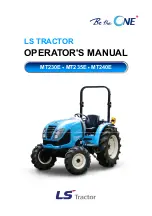
Section 4: Operating Procedures
9/28/18
RB1660, RB1672, RB1684, RB2672, RB2684, & RB2696 Rear Blades 301-375M
19
Backfilling
WARNING
!
To avoid serious injury or death:
Do not tilt blade when backfilling. Tilting the blade to backfill
can result in lost of control and damage the unit.
Backfilling is a process where the operator turns the
blade around 180
o
and pushes the product while
backing-up. Be careful not to overstress the Rear Blade
while backfilling as load forces on the blade and frame
increase when backing up. To help protect the Rear
Blade from damage, lengthen tractor’s center top link
until the blade will move across the top of the ground
without forcing itself into the soil, adjust offset to be
straight behind the tractor and set blade angle at 90
o
(perpendicular to the Mainframe). Keep load in the center
of the blade and not on the end of the blade. Don’t ram a
load with the blade and always operate at slow speeds
when backing-up. Be ready to stop immediately if a solid
object is hit. Removing snow while backing-up is
especially dangerous as snow can hide solid objects and
there is a tendency to drive too fast to get the snow
removal job done. High speeds multiply forces exerted on
the Rear Blade.
Basic Operating Instructions
1.
Thoroughly inspect the work area for buried utility
cables, pipelines, sprinkler heads, and any
unforeseen objects. Mark any potential hazards.
2. Place grade stakes if you intend to develop a specific
grade or soil level.
3. Adjust blade to the desired angle, tilt, and offset
positions before lowering blade to the ground.
4. Lower blade to ground and proceed forward at a
speed of no more than 2 to 4 mph. The blade should
immediately begin shaving the soil surface.
5. Set tractor’s draft-link height control lever to the
desired grade position. If blade is set at a 90 degree
angle to the direction of travel, it may be necessary to
raise the blade slightly so that dirt and gravel can flow
out evenly under the blade as it shaves off high spots
and fills in potholes or depressions.
General Operating Instructions
Once you have familiarized yourself with the Operator’s
Manual, completed operations checklist, and properly
attached your Land Pride Rear Blade to your tractor, you
are almost ready to begin work. Hopefully you have
checked out your work site for any buried utility cables,
pipelines, sprinkler heads, or other obstacles that you
wouldn’t want to damage or encounter. Grade stakes
should now be in place if you intend to develop a specific
grade, elevation, soil contour, or roadbed crown.
The Rear Blade’s primary purpose is for grading or
leveling of soil, gravel, or aggregate in the warmer
months or snow removal in the colder months. These
functions are best done at an approximate 2 to 4 mph
ground speed. Becoming proficient with a rear blade
takes practice. Tractor horsepower, your personal skill
level, soil or aggregate composition, moisture levels, and
compaction factors will all have a definite impact on how
easily and effectively you get the job done. Develop a
plan to achieve your expected results. Set the blade up at
the proper angle or angles to do the job. This may require
some experimentation to achieve the desired results.
Lower Rear Blade to the ground and proceed forward at
a speed of no more than 2 to 4 mph. The blade should
immediately begin shaving the soil surface and dirt or
aggregate material. Set the tractor’s draft-link height
control in the desired position. With blade angle set at 90
degrees, you may need to raise the blade slightly so that
the dirt or gravel can flow out evenly under the blade
while effectively shaving off high spots and filling in
potholes or depressions. Skid shoes on the
Rear Blade can help maintain a consistent blade height.
If you have the blade set at an angle, the shaved or
accumulated material will begin to move outward toward
the trailing edge of the blade. The greater the angle the
more quickly the shaved material will be distributed off to
the side. If it is necessary to work up next to a foundation,
abutment, or raised curb, you my want to offset the blade
so that the outside edge is beyond the outer edge of the
tractor tire. Back-filling operations may be more easily
performed by reversing the blade and operating the
tractor in reverse or commonly called the push mode. Be
careful not to overstress the rear blade while back-filling
as load forces on the blade and frame increase while
backing-up.
If you are performing construction of soil contours or
waterways, you will probably need to set a tilt angle on
the blade to achieve the desired effect. If you are grading
or cutting a new ditch bank or forming a road crown, you
will probably want to offset the blade in combination with
setting an appropriate tilt angle. This again will likely
require some experimentation to gain desired results.
Snow removal techniques with a blade will be very similar
to dirt working techniques and will require a little
experimentation to become proficient.
With a little practice you should become a very good Rear
Blade operator and consistently achieve the desired
results you expect with your Land Pride RB16 Series or
RB26 Series Rear Blade.
See “
Specifications & Capacities”
“Features & Benefits”
on page 23 for additional
information and performance enhancing options.










































